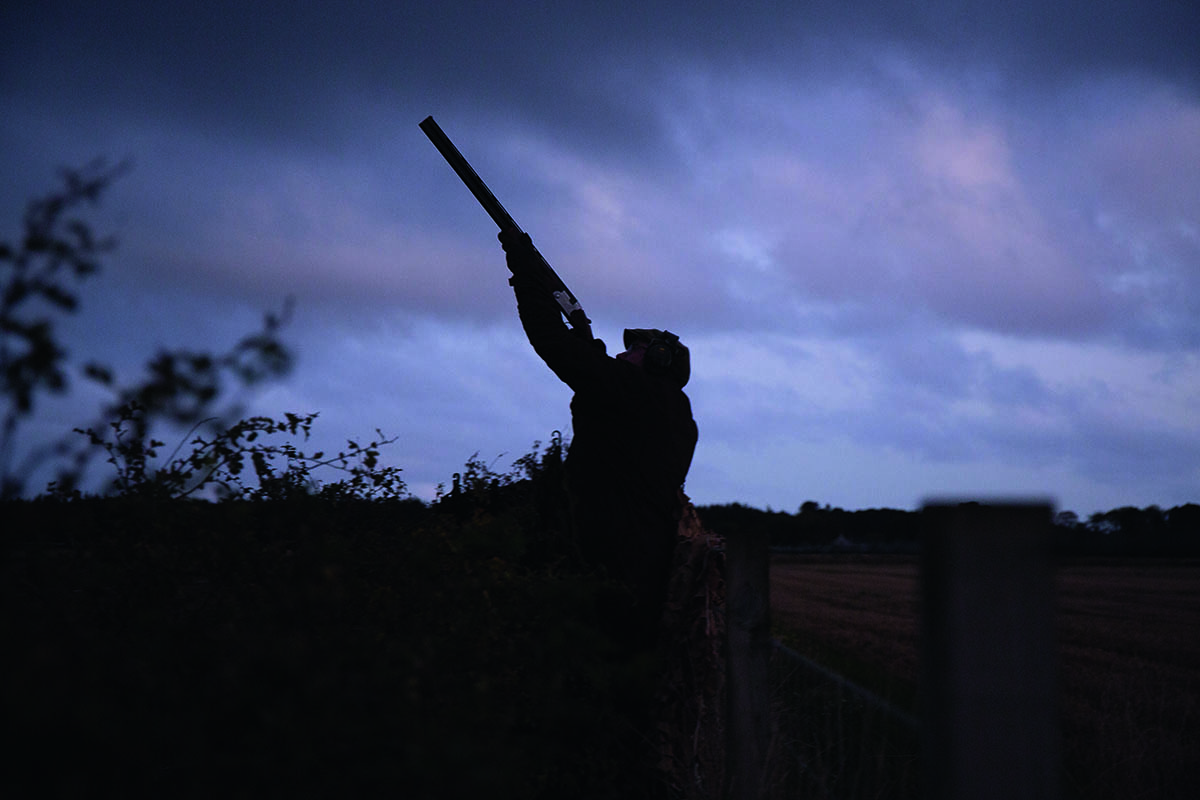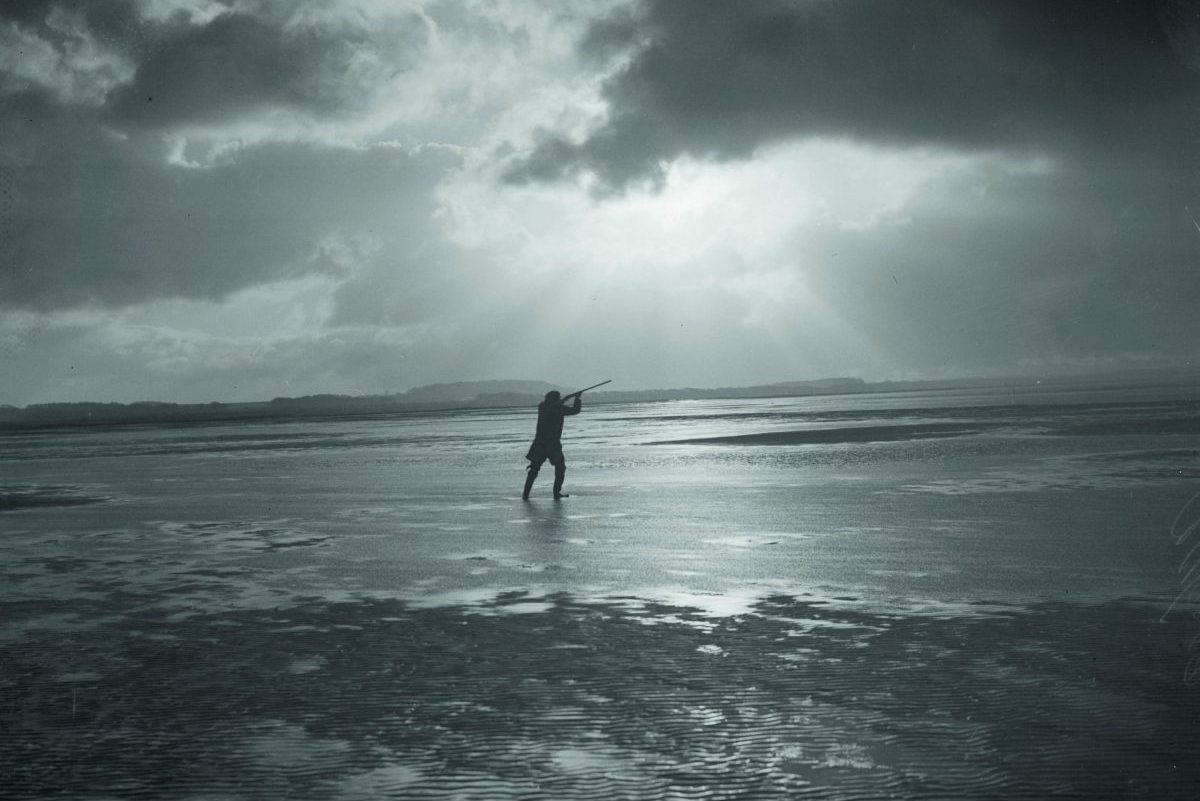Wildfowling for the pink-footed goose
During a long-awaited outing, Tim Maddams calls in a bird for the very first time, eventually bringing home four geese for the table

As the disturbed geese from the field behind fly over Tim Maddams, he quickly drops one from the group
The pink-footed goose, or pinks as they are known round here, are not a species I was familiar with when I lived in Devon. I knew of them of course, but they don’t tend to make it that far south on their annual migration from their breeding grounds in Greenland, Iceland and Svalbard. They prefer the rugged, open landscape of the Scottish coast to the rolling hills of south-west England — and these days, so do I.
It feels a little incautious to be extolling the virtues of wildfowling when we are potentially staring down the proverbial barrel of a wildfowling moratorium in light of the worsening bird flu outbreak, but I will endeavour to do so — a joyful task indeed for the most part. Let’s start with the species.
I do not claim to be an expert wildfowler but I do love chasing wild birds, and the skeins of pinks that start to dot the stratosphere from mid-September as they make their way to our shores for the winter always set the heart racing. There are, I am told, places and guides in northern Scotland where you can organise a trip to come and shoot some. There seems no obvious reason not to do so; the British Trust for Ornithology lists them as an amber species in the UK and of least conservation concern in Europe. It estimates the UK wintering population at a little over 500,000 birds. Certainly, the farmers around my neck of the woods view them mostly as a bit of a pain, particularly on winter barley fields.
With no or very little concern over population, the temptation to get ‘stuck in’ when there are a lot of birds is strong. But it seems that most people limit themselves to what they want to eat. That said, the meat is superb, so getting ‘stuck in’ in the field and then getting ‘stuck in’ in the kitchen is far from a burden. (Read here for Tim Madden’s delicious recipe for pink footed goose with tiger sauce).
Dwindling numbers
Having got quite excited about an invitation from a local keeper, I was disappointed when I came down with Covid, a disposition not entirely helped by the keepers’ footage of skein after skein heading into the field I had planned on shooting. Over the next fortnight, I slowly watched the numbers dwindle from thousands to hundreds to dozens. The large groups of geese split up into smaller, more widely distributed groups as they settle in for the winter — heading off to the Findhorn Basin overnight and coming back inland slightly on their morning flights to the daytime roosts.

Vast numbers of pink-footed geese fly past Tim in the distance, and are a sight and sound to behold
The only other thing I kept seeing was the annoying red line on the rapid antigen tests. Eventually I managed to test negative and, at last, a goose flight was on the cards. The keeper even kindly offered to set up the decoys. I think he was feeling sorry for me.
The morning arrived. A quick cup of tea before sun-up, feed the dogs, load the car and sneak off from the house — without disturbing anyone still abed in the holidaying household. With the younger members of the family being off school for the ‘tattie’ holidays, I was ruminating on the likelihood of either of the offspring bothering themselves to pop out and glean any ‘tatties’ from the local fields as tradition dictates.
I pulled my trusty van into the field gateway, unloaded and headed over the stubbles to find the keeper. The decoys were put out, and I could hear geese flighting in. They were landing in a harvested tattie field behind us, and the helpful keeper suggested that once I was ready, he would drive round the long way to move them off. With a bit of luck, I’d be in business.

Local keeper Ben sets up the decoys, and the pattern is successful at attracting a number of pinks
The magical sound of geese
I settled into the hide and the feelings kicked in — hearing intensified and nerves strained. Geese were fighting, honking and whistling to each other as they worked out who was where and if they were coming into land or not. Off in the distance, a curlew was calling, and an oystercatcher put on a show along with a couple of small skeins of swans. They reminded me of a local Victorian author who wrote a book about wildfowling around here, and his tale of shooting a swan so large that the local lad he employed to fetch his shot birds struggled to drag it, let alone pick it up.
Then, my trance was abruptly broken by that magical sound of around 100 geese suddenly taking flight, disturbed no doubt by my host. But would they make it over me? And even if they did, would they do so at a sensible height?

Patience pays off as Tim successfully whistles in his first goose to the decoys
It seemed like forever as the sound of geese got louder and louder, to the point I felt like they had to be above me. A sneaky peek over the hide net revealed they were some way off still. It looked as though they would go wide of my position, but then they changed course. Before I knew it, they were directly above me and gaining height. Time for action.
A quick first shot resulted in a goose down, and I spent maybe a little too long watching to mark it before focusing on a second — predictably, I fluffed the double — but one bird is still a success. The lone goose was safely retrieved and I settled back into my hide to see what would occur next.
More on wildfowling
- Flightlines and other tactics – how to shoot ducks without using decoys
- Wildfowling for beginners
- How to be a successful and stealthy wildfowler
- The best wildfowling gear for the season ahead
Geese in transit
The break in action was just long enough for the mind to wander — in this instance, my thoughts turned to steel goose loads and wondering whether there’s actually some much better than we’ve had a chance to try yet. But my train of thought was interrupted by a higher purpose. Skein after skein was heading straight past. I call these GITs — ‘geese in transit’. Nothing will turn them, least of all my poor, fledgling attempts to whistle them in.
After what seemed like a frustrating age, as the sky lightened more and a few spots of rain fell, a single goose on the lookout for company flew over and over at some height, clearly keen on the decoys but not quite sure. I whistled. Two high-pitched peeps, slightly lower on the second, but as loud as I could. To my astonishment, the bird replied.

Tim takes a quick left-and-right, adding two more pinks to the bag
I whistled again. The goose turned, opened its wings and came down slowly, right into the decoy pattern — and right into the pattern of shot, too. Hit hard with the first and finished cleanly with the second, I was pleased beyond measure. This was the first goose I have called to the decoys, and despite the shoddy shooting — it should not have required two shots — this was a moment in which to revel.
I was then watching and trying to call in a small group of eight, when out of the corner of my eye another single dropped into the pattern seemingly out of nowhere — a sitting goose. I am ashamed to say I missed it, twice, such was my excitement. We all make muppets of ourselves from time to time.
However, there was little time for self-berating, as a group of three was coming in. I thought they were about to commit to the decoys and, having spooked a group earlier by moving too soon in the morning light, I waited. The occasional call kept them interested. They seemed intent on landing in the tattie field out of range, but then they lifted, looped round and came right into the middle of the decoys. I took a swift and decisive left-and-right. I fluffed a quick reload for the third, failing to take off the safety in my haste to get the trio.
An experience to treasure
With the morning now fully light and four geese in the bag, I decided to draw stumps and headed off to the car to fetch the dog. The birds would be easy to retrieve by hand — I had already brought the first two into the hide to avoid spooking incomers — but the opportunity to give the dog a retrieve is always appealing.

Making the most of the training opportunity, Tim sends Monty out to retrieve the last two geese
I packed up the decoys and hide, and the keeper returned to see how I had got on. It’s hard to describe the feeling of sitting in a hide watching and listening to geese flight around you — the anticipation curdled with care and tempered with experience. It truly is a privilege to shoot wild birds, and one to be treasured.
Four geese will also feed the family well, with the older birds destined for mince — we love a goose sausage in my house — and the younger ones for stir fries. It was a magical morning in a special place, a short drive from home. In the moment, the move north seemed totally worth it.








